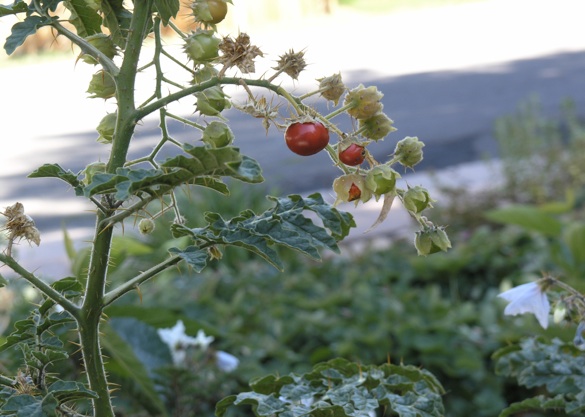Litchi Tomato
By
Paula Szilard
Sometimes it seems that I’m fixated on solanaceous plants, having just done an article on tomatoes. In a sense, I am. There are so many fascinating and good tasting solanaceous fruits and vegetables that people in North America have never encountered, mostly native to the Andes. Well, I encountered some interesting seeds last spring in the Baker Creek Heirloom Seeds catalog (www.rareseeds.com) that I couldn’t resist. I started them under lights and I planted the lone survivor out in a container on my front Patio in
late May.

This was really a WILD looking member of the Solanaceae family that looked a little like a tomato, but not quite. It had a little of that tomato look and it had sharp yellow prickles, so you had to be careful not to get too close and wear leather gloves if you handled it. It had purplish white flowers about 1 ½ inches in diameter that were typical of other Solanaceae and it grew huge. By the end of the season it was over 5 foot tall and 3 ft wide and I wondered what I had wrought. Should I confess that the weekly applications of water soluble fertilizer might have had something to do with the size? On the plus side, it did have tasty, if seedy fruits the size of a large cherry that were red on the outside and yellow on the inside. For the best flavor, you had to let them get really ripe.
Everyone who walked in and out of my front door was intrigued and the more adventurous among them could enjoy a couple of these interesting fruits, which tasted a little like a cherry and a little like a tomato. Many people tried them and some even took the fruits home to save the seeds. It’s been suggested that the seeds be chilled 4-6 weeks of cold treatment before planting. I did not do this with my purchased seeds and they still germinated.
The plant goes by several different names. Baker Creek called it litchi tomato. It is also known as Morelle de Balbis, Sticky Nightshade and Fire and Ice. Botanically, it is Solanum sisymbriifolium. Often cultivated as an ornamental, it has become naturalized in parts of Australia and the southeastern United States. Indeed, some people consider it a weed.
It originates in the more temperate areas of South America. It is found in Brazil, Paraguay, and Argentina. We can grow it as an annual, but in some environments it can also be a short lived perennial. Commercially, it has been used as a trap crop to protect potatoes from potato cyst nematode. If some breeding work were done to increase sweetness and decrease seediness, it could become a useful fruit. Why not try it! You might like it.
